Lava flow from fissure 8 might go on for months or years


COURTESY USGS
A Hawaiian Volcano Observatory geologist stood Thursday on airborne lava fragments, such as Pele’s hair, that erupted from and deposited downwind of the fissure 8 vent. He was there to observe vent activity and to capture both thermal and video imagery of the pulsations occurring in the near-vent channel.

COURTESY USGS
Fissure 8 remains the main exit point of magma from Kilauea and could continue for months to years.



The Kilauea eruption — which began May 3 and has destroyed more than 700 homes — “most likely” could continue for months to years.
That’s the conclusion of a recent U.S. Geological Survey report Opens in a new tab prepared for Hawaii County Civil Defense.
The authors said the sustained flow of magma from the summit so far leads them to believe it will be some time before the eruption ends.
The range of duration is broad and remains unpredictable, scientists said Monday afternoon during a phone conference.
The document, posted online Opens in a new tab, is intended as a guide for managing the hazards and risks on Kilauea’s lower East Rift Zone. In addition to the homes destroyed, the eruption has covered farms, a school and beloved recreational areas.
“Given this volume and the sustained withdrawal of magma from the summit reservoir without appreciable deformation in the lower East Rift Zone, it is most likely that the LERZ (lower East Rift Zone) eruption may continue for months to years,” the report said.
Don't miss out on what's happening!
Stay in touch with breaking news, as it happens, conveniently in your email inbox. It's FREE!
Steve Brantley, USGS deputy scientist in charge, said the volume of lava erupting into the lower East Rift Zone, so far, is quite high compared with the volumes of historical eruptions dating back to 1940.
“The continued subsidence of the crater up at Halemaumau implies directly that magma is withdrawing from the summit reservoirs and moving down the lower East Rift Zone into fissure 8,” said Brantley. “So there’s a very large volume of magma there that can supply lava rates for quite some time.”
If the ongoing eruption maintains its current style of activity at a high eruption rate, the report said, then “it may take months to a year or two to wind down.”
So far, the current eruption has not lasted as long as the 1955 eruption — which was 88 days, including pauses — but it has erupted far more lava at a higher rate.
“This current eruption is unlike any that we have experienced; no one is able to predict how long the eruption will last,” said Mayor Harry Kim in an email. “Our County Civil Defense works to ensure the community’s safety, regardless of the duration of this event.”
USGS recorded another collapse event at Kilauea’s summit at 8:54 p.m. Sunday, with energy equal to a 5.3-magnitude earthquake. There was no tsunami threat to Hawaii island. A few overflows were found just northwest of Kapoho Cone but stalled before threatening any structures.
More than 50 “collapse events” have occurred at Halemaumau since the eruption began May 3; they repeat approximately once every 30 hours.
Halemaumau Crater, meanwhile, continues to “slump,” meaning parts of its rim and walls are sloughing off, resulting in a larger diameter and deeper depth. Since mid-May, USGS said, the depth of the crater has more than tripled, and the diameter more than doubled.
How much larger the crater will become also remains unknown, according to Brantley.
Sunday’s collapse caused additional damage to Highway 11 between mile markers 28 and 32 near Volcano, state officials said. Motorists are urged to drive with extreme caution in the area.
At the oceanfront the flow remains about a quarter-mile from the Pohoiki boat ramp at Isaac Hale Park. The lava delta area now measures about 740 acres and extends about a half-mile from the pre-eruption coastline. It could potentially collapse without warning, leading to explosions.
The focus of the report is on fissure 8, which first became active May 5 and erupted “with a vigorous fountain” May 27, producing a relatively fast-moving, channelized flow going northeast. Two days later the flow crossed Pohoiki Road and Highway 132, and reached Kapoho Bay on June 3.
By the end of June, the fountaining from fissure 8 built a spatter cone about 180 feet high, with lava from the vent continuing to feed into an 8-mile-long channel to the ocean at about 50 to 150 cubic meters per second.
If the cone or channel walls fail, or if narrower braids of the channel get blocked, the lava could take a new course.
Several scenarios that could come from fissure 8, which as of Monday continued to send lava to the ocean, with an active ocean entry southeast of Ahalanui, were mapped out in the report. Hawaiian Volcano Observatory focused on scenarios where lava flows to the north of the existing channel system, where residents have not yet been evacuated.
If there is an upper channel breach — in the channel between the vent and Pohoiki Road/Highway 132 — USGS said it is likely to advance northeast and continue along the eastern boundary of the Nanawale Estates subdivision, ultimately crossing Railroad Avenue and Government Beach Road. It could reach the ocean southeast of Kahakai Boulevard or slightly closer to the Hawaiian Beaches and Hawaiian Shores subdivisions.
With a middle channel breach, which could happen if one of the braided sections of the channel is blocked, lava could be redirected to the north, threatening homes in the Noni Farms area and Railroad Avenue, Papaya Farms and Government Beach roads. It would enter the ocean between Kalamanu and the northern edge of the 1960 lava flow.
There also could be a lower channel breach. On July 9 and 10 the channel overflow northwest of Kapoho Crater created a new lobe that advanced south, destroying Kua o ka La Public Charter School and Ahalanui warm ponds. The flow north and east of Kapoho Crater to the ocean is still oozing lava into the ocean and could widen, threatening remaining structures in the Kapoho Ags and Beach lots, along with Cape Kumukahi Lighthouse.
Elizabeth Kekidi, owner of Alohilani Orchids on Railroad Avenue, said she still plans to keep her nursery going at the border of Kalapana. Her orchids are doing fine, she said, as long as trades blow the other way.
“I’m going to try to hang on,” she said. “I’m hoping. For some reason I don’t believe it’s going to last. Maybe in the next month or two, I think, it’ll be over.”
Her greatest challenge, she said, is limited access into and out of her nursery, which is currently accomplished by taking back roads. If lava cuts off those roads, however, she will be in trouble.



